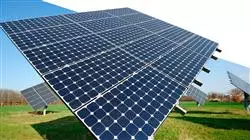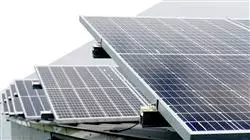University certificate
Scientific endorser

The world's largest faculty of engineering”
Introduction to the Program
Thanks to this 100% online Professional master’s degree, you will develop the most effective preventive maintenance plans to guarantee the continuous and efficient operation of photovoltaic systems"

Photovoltaics has become an essential solution for decarbonizing the energy sector and mitigating climate change. Advances in solar cell efficiency, cost reduction and increasing energy storage capacity are driving unprecedented adoption of PV technology. In this context, engineering professionals must keep abreast of the current state of the art in the PV field. Only in this way will they be able to overcome the challenges of grid integration and incorporate the most cutting-edge strategies for its implementation into their practice.
In this scenario, TECH launches a pioneering and very complete Professional master’s degree in Photovoltaic Solar Energy. Designed by experts in this field, the academic itinerary will cover issues ranging from the location of photovoltaic installations or administrative aspects to the maintenance of photovoltaic plants. During the course of the program, graduates will acquire advanced skills to effectively handle the most sophisticated design, simulation and sizing software. At the same time, the syllabus will analyze the most innovative strategies to optimize sizing.
In order to consolidate the mastery of all these contents, the university program applies the innovative Relearning system. TECH is a pioneer in the use of this teaching model, which promotes the assimilation of complex concepts through their natural and progressive reiteration. Also, the academic itinerary is nourished by materials in various formats such as explanatory videos and infographics. All this in a convenient 100% online modality that allows students to adjust their schedules according to their responsibilities and availability. In this sense, the only thing experts will need is an electronic device with an Internet connection to access the Virtual Campus. In this way, they will be able to enjoy the most complete and up-to-date teaching materials on the educational market.
The Virtual Campus will be available to you 24 hours a day, so that you can access it at the time that suits you best"
This Professional master’s degree in Photovoltaic Solar Energy contains the most complete and up-to-date program on the market. The most important features include:
- The development of case studies presented by experts in Photovoltaic Solar Energy
- The graphic, schematic, and practical contents with which they are created, provide practical information on the disciplines that are essential for professional practice
- Practical exercises where the self-assessment process can be carried out to improve learning
- Its special emphasis on innovative methodologies
- Theoretical lessons, questions to the expert, debate forums on controversial topics, and individual reflection assignments
- Content that is accessible from any fixed or portable device with an Internet connection
You will delve into the Calculation of Radiation on Tilted Surfaces, which will allow you to maximize the harvesting of solar energy"
The program’s teaching staff includes professionals from the field who contribute their work experience to this educational program, as well as renowned specialists from leading societies and prestigious universities.
The multimedia content, developed with the latest educational technology, will provide the professional with situated and contextual learning, i.e., a simulated environment that will provide immersive education programmed to prepare for real situations.
This program is designed around Problem-Based Learning, whereby the professional must try to solve the different professional practice situations that arise during the course. For this purpose, the students will be assisted by an innovative interactive video system created by renowned and experienced experts.
Looking to incorporate into your practice the most sophisticated strategies to maximize the performance of photovoltaic systems? Achieve it with this program in just 12 months"

Thanks to the Relearning method, you will be able to consolidate the key concepts offered by this university course"
Why study at TECH?
TECH is the world’s largest online university. With an impressive catalog of more than 14,000 university programs available in 11 languages, it is positioned as a leader in employability, with a 99% job placement rate. In addition, it relies on an enormous faculty of more than 6,000 professors of the highest international renown.

Study at the world's largest online university and guarantee your professional success. The future starts at TECH”
The world’s best online university according to FORBES
The prestigious Forbes magazine, specialized in business and finance, has highlighted TECH as “the world's best online university” This is what they have recently stated in an article in their digital edition in which they echo the success story of this institution, “thanks to the academic offer it provides, the selection of its teaching staff, and an innovative learning method aimed at educating the professionals of the future”
A revolutionary study method, a cutting-edge faculty and a practical focus: the key to TECH's success.
The most complete study plans on the university scene
TECH offers the most complete study plans on the university scene, with syllabuses that cover fundamental concepts and, at the same time, the main scientific advances in their specific scientific areas. In addition, these programs are continuously being updated to guarantee students the academic vanguard and the most in-demand professional skills. In this way, the university's qualifications provide its graduates with a significant advantage to propel their careers to success.
TECH offers the most comprehensive and intensive study plans on the current university scene.
A world-class teaching staff
TECH's teaching staff is made up of more than 6,000 professors with the highest international recognition. Professors, researchers and top executives of multinational companies, including Isaiah Covington, performance coach of the Boston Celtics; Magda Romanska, principal investigator at Harvard MetaLAB; Ignacio Wistumba, chairman of the department of translational molecular pathology at MD Anderson Cancer Center; and D.W. Pine, creative director of TIME magazine, among others.
Internationally renowned experts, specialized in different branches of Health, Technology, Communication and Business, form part of the TECH faculty.
A unique learning method
TECH is the first university to use Relearning in all its programs. It is the best online learning methodology, accredited with international teaching quality certifications, provided by prestigious educational agencies. In addition, this disruptive educational model is complemented with the “Case Method”, thereby setting up a unique online teaching strategy. Innovative teaching resources are also implemented, including detailed videos, infographics and interactive summaries.
TECH combines Relearning and the Case Method in all its university programs to guarantee excellent theoretical and practical learning, studying whenever and wherever you want.
The world's largest online university
TECH is the world’s largest online university. We are the largest educational institution, with the best and widest online educational catalog, one hundred percent online and covering the vast majority of areas of knowledge. We offer a large selection of our own degrees and accredited online undergraduate and postgraduate degrees. In total, more than 14,000 university degrees, in eleven different languages, make us the largest educational largest in the world.
TECH has the world's most extensive catalog of academic and official programs, available in more than 11 languages.
Google Premier Partner
The American technology giant has awarded TECH the Google Google Premier Partner badge. This award, which is only available to 3% of the world's companies, highlights the efficient, flexible and tailored experience that this university provides to students. The recognition as a Google Premier Partner not only accredits the maximum rigor, performance and investment in TECH's digital infrastructures, but also places this university as one of the world's leading technology companies.
Google has positioned TECH in the top 3% of the world's most important technology companies by awarding it its Google Premier Partner badge.
The official online university of the NBA
TECH is the official online university of the NBA. Thanks to our agreement with the biggest league in basketball, we offer our students exclusive university programs, as well as a wide variety of educational resources focused on the business of the league and other areas of the sports industry. Each program is made up of a uniquely designed syllabus and features exceptional guest hosts: professionals with a distinguished sports background who will offer their expertise on the most relevant topics.
TECH has been selected by the NBA, the world's top basketball league, as its official online university.
The top-rated university by its students
Students have positioned TECH as the world's top-rated university on the main review websites, with a highest rating of 4.9 out of 5, obtained from more than 1,000 reviews. These results consolidate TECH as the benchmark university institution at an international level, reflecting the excellence and positive impact of its educational model.” reflecting the excellence and positive impact of its educational model.”
TECH is the world’s top-rated university by its students.
Leaders in employability
TECH has managed to become the leading university in employability. 99% of its students obtain jobs in the academic field they have studied, within one year of completing any of the university's programs. A similar number achieve immediate career enhancement. All this thanks to a study methodology that bases its effectiveness on the acquisition of practical skills, which are absolutely necessary for professional development.
99% of TECH graduates find a job within a year of completing their studies.
Professional Master's Degree in Photovoltaic Solar Energy
This Professional Master's Degree in Photovoltaic Solar Energy developed by TECH Global University offers a comprehensive and advanced education, focused on one of the most promising and sustainable fields in the energy sector. This program, taught 100% online, will allow you to acquire in-depth knowledge and practical skills in solar photovoltaic energy, preparing you to face the challenges and take advantage of the opportunities of this constantly evolving technology. Through the syllabus, you will explore everything from the fundamentals of photovoltaics to the latest innovations and trends in the field. You will learn about the physics of semiconductors and how solar cells work, as well as the different types of photovoltaic technologies available on the market. In addition, you will address key aspects of PV project management, from initial planning to implementation and operation. This technical knowledge is complemented by a detailed understanding of PV systems, including the design, installation and maintenance of these systems. Through case studies and hands-on projects, you will develop skills in solar resource assessment, economic feasibility analysis and financing strategies. These competencies will enable you to lead solar energy projects efficiently and effectively, maximizing performance and minimizing risk.
Become a specialist in photovoltaic solar energy
The online modality of the Professional Master's Degree offers you the flexibility to study at your own pace, allowing you to balance your studies with your professional and personal commitments. You will have access to a wide range of educational resources that will provide you with a dynamic and enriching learning experience. As you progress through the program, you will address the policies and regulations that affect the industry, providing a solid framework for understanding the legal and economic context in which solar energy projects operate. In addition, you will learn about government incentives, environmental regulations and market trends that influence the adoption and development of PV technology globally. Upon completion, you will be prepared to take on leadership roles in the PV industry. You will be able to work in renewable energy companies, environmental consultancies, government agencies and international organizations, among others. Your ability to design, manage and optimize solar energy projects will make you a highly sought-after and valued professional in the job market. Enroll now and take the first step towards a sustainable and high-impact career in the renewable energy sector.







